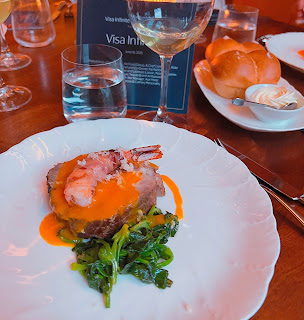European tasting menus that incorporate Japanese influences to
play into food trends or Michelin inspector palettes don’t impress me.
It’s the reason I had reservations of trying Radici Project at the beginning. Until
I heard the restaurant was started by Kayo Ito, a sake sommelier, and Italian Chef
Emiliano Del Frate who also happened to be married. Now this is a mashup I can
get behind.
Their immersive tasting menu ($160 per person) begins
with an amuse bouche trio including a mocktail palette cleanser that looks
fruity but finishes savoury thanks to the garum butter swirled into the
drink.
The drink prepares the taste buds for their crab takoyaki
that incorporates unused portions of the crab head (in a dish to come) captured
in a soft fluffy batter with bonito flakes adding an extra touch of
umami. I found the concept of the savoury waffle too similar (and not as
tasty) and wish the kitchen used the dollops of creamy burrata and crisp kimchi
in something different.
If you don’t like dealing with the crustacean, Radici’s crab
dish is ideal as the sweet crab meat is removed from the shell and paired
with an almond foam and caviar. What’s finished in a few bites must take
a while to prepare but makes for a great start.
The restaurant follows a zero-waste philosophy that you see
throughout the meal. So, when their supplier, Acadian Sturgeon and Caviar Inc.,
started smoking the fish they killed to harvest caviar, the restaurant knew
they needed to feature the product on their menu. And what a wonderful idea it
was to pair the slice of smoked sturgeon with their crusty airy
sourdough and silky whipped butter! The meaty fish tastes like a lean country
ham so really works. I’d love to see more restaurants swap out sturgeon for
swine.
I was intrigued by how curing duck breast in beeswax would
taste. It seems to condense its flavours as the gaminess was more pronounced,
which was why the kitchen paired it with a slice of preserved plum and a
pickled vegetable (?), both elements cutting the richness and gaminess of the
duck.
The karaage e papacelle is a great fusion dish.
It was influenced by Kayo who grew up eating fried chicken, which Chef Emiliano
notes isn’t popular in his Italian village… when he ate chicken, it was usually
roasted and served with potatoes. So, he decided to marry their cultures by
deboning a chicken wing and stuffing it with roasted potatoes. Served with a mascarpone
roasted red pepper sauce it’s deliciously addictive, the fluffy soft potato
contrasting nicely with the crunchy and juicy fried chicken.
At Radici, pink dishes do not signify frilly and light
creations. The beet tajarin tastes like a rich seafood pasta
thanks to garum butter studded with smoked caviar. The pasta was done
beautifully and left me longing for just a few more forkfuls.
If food scraps taste this good, I say give us more. The cappellacci
is stuffed with veal trimmings and served in a burnt onion dashi made
from various vegetable scraps. I can still taste the delicious broth that
flooded my mouth with flavours, including the ingenious idea of adding small ginger
slivers and sumac at the bottom so it ends on a bright note.
You can’t go wrong with halibut and maitake,
one poached and the other grilled creating a creamy smoky dish. Yet, it’s the peperone
crusco oil that really wakes up the fish adding a bright zing of spice that
shone through the two richer elements.
We’re told to try the veal by itself and leave the
portion topped with a cilantro flower last. I was waiting for a huge pop of
floral or citrus, but it didn’t taste that different. If anything, the sparkling
red wine paired with the dish surprised me more. It paired well with the tender
beef and silky sweet smoked parsnip puree.
In fact, I’d recommend going with their drink pairings. The mix
wine and sake flight ($70 for 4 drinks) complimented the meal and
incorporated such different drinks including a yeasty sparkling sake, orange
wine, a white, and the aforementioned sparkling red.
Dinner ended with a delicious honey cake topped with camomile
gel and whipped cream. It tasted so light and fluffy adorned with honey and
buttery cookie elements to give the dish extra pops of flavours and textures.
I’ve been lucky to have dined at many Toronto restaurants before
they were granted a Michelin star and getting a reservation became difficult. I’m
predicting that Radici Project will be a star contender. Their food is inventive
and delicious but improving their plating aesthetics and tweaking the service is
needed. It’s small things like ensuring the drink pairing is on the table
before the food arrives, which can be easily solved by allowing the sommelier to
be dedicated to drinks and not also serving food.
At least they have the welcoming and warm environment down. And
I enjoyed the whimsical touches like the Jenga block cutlery holder that became
a necessity when the wooden ones they sourced weren’t big enough to hold the
cutlery. Since Jenga is a go-to game for Kayo, they bought a box, and it’s
works beautifully.
As the Radici Project continues, I can’t wait to see how it
morphs and grows.
Address: 588 College Street
____________________________
Gastro World's Grading System
- Anything under 5 - I really disliked and will never go back
- 6 - decent restaurant but I likely won't return
- 7 - decent restaurant and I will likely return
- 8 - great restaurant that I'd be happy to recommend
- 9 - fantastic restaurant that I would love to visit regularly and highly recommend
- 10 - absolute perfection!
Is That It? I Want More!
Other Gastro World posts similar to this:

































































